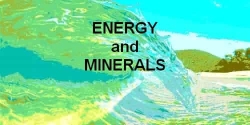Solar Energy
Solar Energy
source based on web page by Ken Cromptonhttps://www.acs.org/content/acs/en/education/resources/highschool/chemmatters/past-issues/archive-2013-2014/how-a-solar-cell-works.html?cq_ck=1396892718960
Solar Photovoltaics - electricity from the sun
Types of Photovoltaic (PV) Cells in Common Use
How Solar Photovoltaic Cells Work
Solar Thermal Energy
Glossary of PV Terms
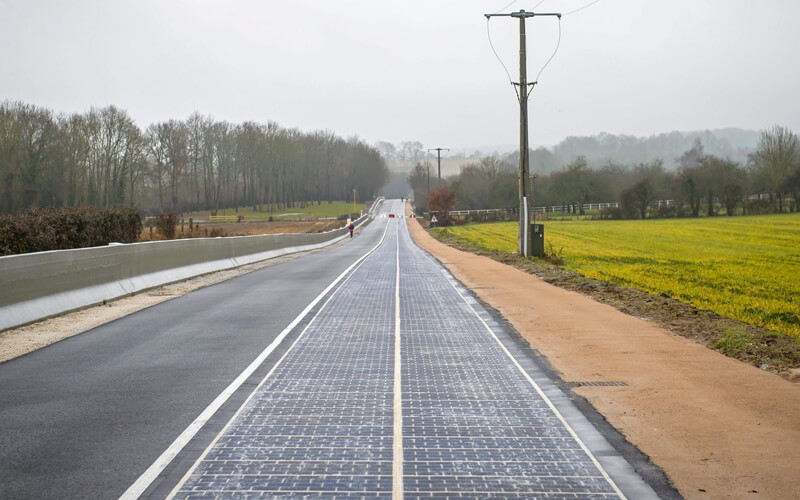
Solar Photovoltaics - electricity from the sun
Photovoltaic (or PV) systems convert light energy into electricity. The
term "photo" is a stem from the Greek "phos," which means "light."
"Volt"is named for Alessandro Volta (1745-1827), a pioneer in the study of
electricity. "Photo-voltaics," then, could literally mean
"light-electricity. Most commonly known as "solar cells," PV systems are
already an important part of our lives. The simplest systems power many of
the small calculators and wrist watches we use every day. More complicated
systems provide electricity for pumping water, powering communications
equipment, and even lighting our homes and running our appliances. In
asurprising number of cases, PV power is the cheapest form of electricity
for performing these tasks.This technology converts sunlight directly into electricity using photovoltaic (PV) cells. The solar PV cells are combined in panels. They can be put on rooftops, integrated into building designs and vehicles, or installed by the thousands across fields to create large-scale solar power plants. Concentrating solar PV uses fields of sun-tracking mirrors called heliostats to concentrate sunlight onto highly efficient PV cells located inside a receiver at the top of a mast or tower.
Movement of Light
The movement of light from one location to another can best be described as though it were a wave, and different types of radiation are characterised by their individual wavelengths (a wavelength is the distance from the peak of one wave to the peak of the next). These wavelengths indicate radiation with different amounts of energy; the longer the wavelength, the less the energy. Red light, then, has a longer wavelength and thus has less energy than violet light.
Each second, the sun releases an enormous amount of radiant energy into the solar system. The Earth receives a tiny fraction of this energy; still, anaverage of 1367 watts (W) reaches each square meter (m2) of the outer edge of the Earth's atmosphere. The atmosphere absorbs and reflects some of this radiation, including most X-rays and ultraviolet rays. Still, the amount of sunshine energy that hits the surface of the Earth every minute is greater than the total amount of energy that the world's human population consumes.
The Earth's atmosphere and cloud cover absorb, reflect, and scatter some of the solar radiation entering the atmosphere.Nonetheless, enormous amounts of direct diffuse sunshine energy reach the Earth's surfaceand
can therefore be used to produce photovoltaic electricity.
Photovoltaic cells convert sunlight into electricity A photovoltaic (PV) cell, commonly called a solar cell, is a nonmechanical device that converts sunlight directly into electricity.
Some PV cells can convert artificial light into electricity.
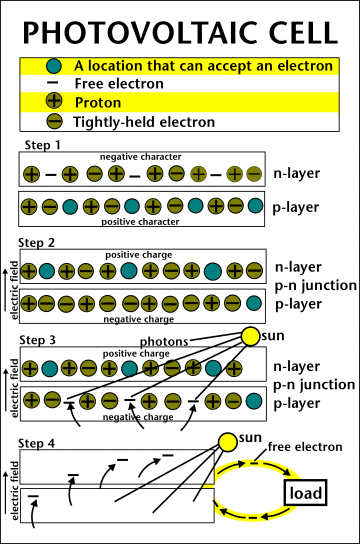
Image of how a photovoltaic cell works.
Photons carry solar energy
Sunlight is composed of photons, or particles of solar energy. These photons contain varying amounts of energy that correspond to the different wavelengths of the solar spectrum.
A PV cell is made of semiconductor material. When photons strike a PV cell, they may reflect off the cell, pass through the cell, or be absorbed by the semiconductor material. Only the absorbed photons provide energy to generate electricity. When the semiconductor material absorbs enough sunlight (solar energy), electrons are dislodged from the material's atoms. Special treatment of the material surface during manufacturing makes the front surface of the cell more receptive to the dislodged, or free, electrons so the that the electrons naturally migrate to the surface of the cell.
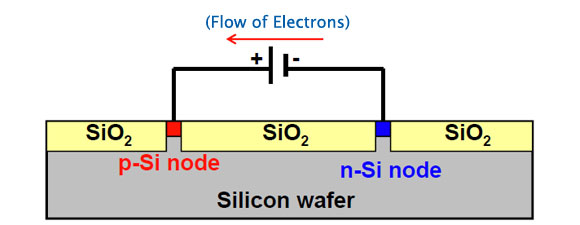
Flow of energy in solar cell
The flow of electricity
The movement of electrons, each carrying a negative charge, toward the front surface of the cell creates an imbalance of electrical charge between the cell's front and back surfaces. This imbalance, in turn, creates a voltage potential like the negative and positive terminals of a battery. Electrical conductors on the cell absorb the electrons. When the conductors are connected in an electrical circuit to an external load, such as a battery, electricity flows in the circuit.
The efficiency of photovoltaic systems varies by the type of photovoltaic technology The efficiency at which PV cells convert sunlight to electricity varies by the type of semiconductor material and PV cell technology. The efficiency of most commercially available PV modules ranges from 5% to 15%. Researchers around the world are trying to achieve higher efficiencies.
How photovoltaic systems operate
The PV cell is the basic building block of a PV system. Individual cells can vary in size from about 1.25cm to about 100cm across. However, one cell only produces 1 or 2 Watts, which is only enough electricity for small uses. PV cells are electrically connected in a packaged, weather-tight PV module or panel. PV modules vary in size and in the amount of electricity they can produce. PV module electricity generating capacity increases with the number of cells in the module or in the surface area of the module. PV modules can be connected in groups to form a PV array. A PV array can be composed of two or hundreds of PV modules. The number of PV modules connected in a PV array determines the total amount of electricity that the array can generate. Photovoltaic cells generate direct current (DC) electricity. This DC electricity can be used to charge batteries that, in turn, power devices that use direct current electricity. Nearly all electricity is supplied as alternating current (AC) in electricity transmission and distribution systems. Devices called inverters are used on PV modules or in arrays to convert the DC electricity to AC electricity. PV cells and modules will produce the largest amount of electricity when they are directly facing the sun. PV modules and arrays can use tracking systems that move the modules to constantly face the sun, but these systems are expensive. Most PV systems have modules in a fixed position with the modules facing directly south (in the northern hemisphere—directly north in the southern hemisphere) and at an angle that optimizes the physical and economic performance of the system.
Applications of photovoltaic systems
The smallest photovoltaic systems power calculators and wrist watches. Larger systems can provide electricity to pump water, to power communications equipment, to supply electricity for a single home or business, or to form large arrays that supply electricity to thousands of electricity consumers. Some advantages of PV systems are PV systems can supply electricity in locations where electricity distribution systems (power lines) do not exist, and they can also supply electricity to an electric power grid. PV arrays can be installed quickly and can be any size. The environmental impact of PV systems is minimal.

Solar cell efficiencies
Types of Photovoltaic (PV) Cells in Common Use
Monocrystalline silicon PV panels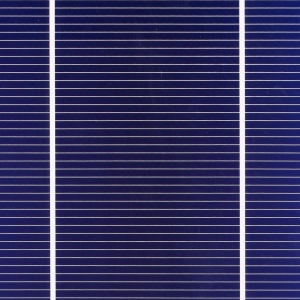
These are made using cells sliced from a single cylindrical crystal of silicon. This is the most efficient photovoltaic technology, typically converting around 15% of the sun's energy into electricity. The manufacturing process required to produce monocrystalline silicon is complicated, resulting in slightly higher costs than other technologies.
Polycrystalline silicon PV panels

Also sometimes known as multicrystalline cells, polycrystalline silicon cells are made from cells cut from an ingot of melted and recrystallised silicon. The ingots are then saw-cut into very thin wafers and assembled into complete cells. They are generally cheaper to produce than monocrystalline cells, due to the simpler manufacturing process, but they tend to be slightly less efficient, with average efficiencies of around 12%.
Thin-film silicon PV panels

This is a variant on multicrystalline technology where the silicon is deposited in a continuous process onto a base material giving a fine grained, sparkling appearance. Like all crystalline PV, it is normally encapsulated in a transparent insulating polymer with a tempered glass cover and then bound into a metal framed module.
Amorphous silicon PV panels

Amorphous silicon cells are made by depositing silicon in a thin homogenous layer onto a substrate rather than creating a rigid crystal structure. As amorphous silicon absorbs light more effectively than crystalline silicon, the cells can be thinner - hence its alternative name of 'thin film' PV. Amorphous silicon can be deposited on a wide range of substrates, both rigid and flexible, which makes it ideal for curved surfaces or bonding directly onto roofing materials. This technology is, however, less efficient than crystalline silicon, with typical efficiencies of around 6%, but it tends to be easier and cheaper to produce. If roof space is not restricted, an amorphous product can be a good option. However, if the maximum output per square metre is required, specifiers should choose a crystalline technology.
Other thin film PV panels
A number of other materials such as cadmium telluride (CdTe) and copper indium diselenide (CIS) are now being used for PV modules. The attraction of these technologies is that they can be manufactured by relatively inexpensive industrial processes, certainly in comparison to crystalline silicon technologies, yet they typically offer higher module efficiencies than amorphous silicon. Most offer a slightly lower efficiency: CIS is typically 10-13% efficient and CdTe around 8 or 9%. A disadvantage is the use of highly toxic metals such as Cadmium and the need for both carefully controlled manufacturing and end-of-life disposal; although a typical CdTe module contains only 0.1% Cadmium, which is reported to be lower than is found in a single AA-sized NiCad battery.
How solar cells make electricity
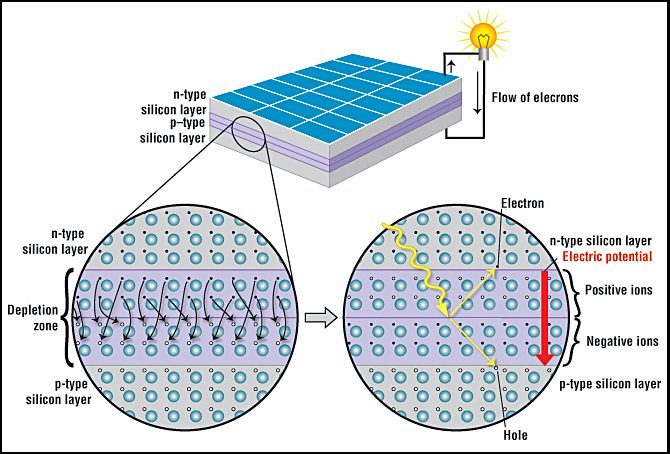
How Solar Photovoltaic Cells Work
A solar cell is made of two types of semiconductors, called p-type and n-type silicon.The p-type silicon
is produced by adding atoms—such as boron or gallium—that have one less electron in their outer energy level than does silicon. Because boron has one less electron than is required to form the bonds with the surrounding silicon atoms, an electron vacancy or “hole” is created.
The n-type silicon
is made by including atoms that have one more electron in their outer level than does silicon, such as phosphorus. Phosphorus has five electrons in its outer energy level, not four. It bonds with its silicon neighbor atoms, but one electron is not involved in bonding. Instead, it is free to move inside the silicon structure. A solar cell consists of a layer of p-type silicon placed next to a layer of n-type silicon In the n-type layer, there is an excess of electrons, and in the p-type layer, there is an excess of positively charged holes (which are vacancies due to the lack of valence electrons). Near the junction of the two layers, the electrons on one side of the junction (n-type layer) move into the holes on the other side of the junction (p-type layer). This creates an area around the junction, called the depletion zone, in which the electrons fill the holes
When all the holes are filled with electrons in the depletion zone, the p-type side of the depletion zone (where holes were initially present) now contains negatively charged ions, and the n-type side of the depletion zone (where electrons were present) now contains positively charged ions. The presence of these oppositely charged ions creates an internal electric field that prevents electrons in the n-type layer to fill holes in the p-type layer.
When sunlight strikes a solar cell, electrons in the silicon are ejected, which results in the formation of “holes”—the vacancies left behind by the escaping electrons. If this happens in the electric field, the field will move electrons to the n-type layer and holes to the p-type layer. If you connect the n-type and p-type layers with a metallic wire, the electrons will travel from the n-type layer to the p-type layer by crossing the depletion zone and then go through the external wire back of the n-type layer, creating a flow of electricity.
AC and DC Current
PV modules, because of their electrical properties, produce direct rather than alternating current (ac). Direct current (dc) is electric current that flows in a single direction. Many simple devices, such as those that run on batteries, use direct current. Alternating current, in contrast, is electric current that reverses its flow direction at regular intervals. This is the type of electricity provided by utilities and is required to run most modern appliances and electronic devices.
In the simplest systems, dc current produced by PV modules is used directly. In applications where ac current is necessary, an inverter can beadded to the system to convert the dc current to ac current.
Factors Affecting Efficiency of Cells
When sunlight strikes a solar cell, only certain bands (or wavelengths)of light will cause electrons to move within the semiconductor, thereby producing electric current. The energy "band gap" of the semiconductor determines the ideal portion of the light spectrum that will create this effect. To allow it all to happen, the semiconductor layers must be constructed so as to produce an electric field. The wavelengths of light above the cell's band gap carry more energy. Some of this energy is absorbed to free electrons in the cell,and some of it is absorbed as heat. Light energy below the cell's band gap passes right through the field without affecting electron movement. Overall, only abut 55% of the sun's light energy can be converted into electricity.

Only certain wavlengths of light cause electron to move
.

The wavelengths above thecell's band gap carry more energy

So, the typical solar cell receives the entire solar spectrum.
But only the light energy above the cell's energy gap
will cause electrons to move and become part of an electric circuit.
Solar Thermal Energy
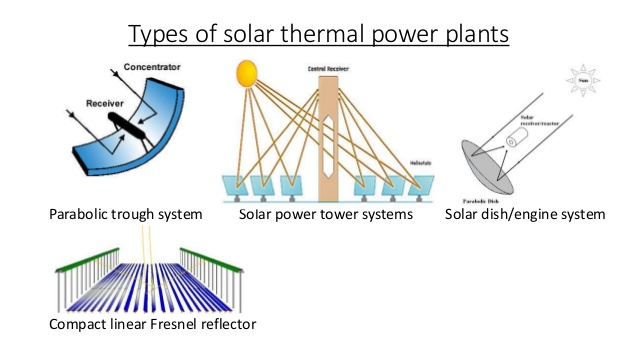
This technology converts sunlight into thermal energy (or heat), which in the past has been used mainly for space heating or to heat water (such as in a solar hot water system). This heat energy can be used to drive a refrigeration cycle to provide solar-based cooling, or to make steam that can be used to generate electricity using a steam turbine. Solar thermal energy can also be used in some industrial processes that currently use gas to produce heat. Concentrating solar thermal technology harvests the sun’s heat to produce efficient, large-scale power generation. It uses a field of mirrors to reflect sunlight onto a thermal receiver, which transfers the heat to a thermal energy storage system. Energy can then be released from storage as required, day and night.
Solar thermal power systems use concentrated solar energy
Solar thermal power generation systems collect and concentrate sunlight to produce the high temperature heat needed to generate electricity.
All solar thermal power systems have solar energy collectors with two main components: reflectors (mirrors) that capture and focus sunlight onto a receiver.
In most types of systems, a heat-transfer fluid is heated and circulated in the receiver and used to produce steam. The steam is converted into mechanical energy in a turbine, which powers a generator to produce electricity. Solar thermal power systems have tracking systems that keep sunlight focused onto the receiver throughout the day as the sun changes position in the sky. Solar thermal power systems may also have a thermal energy storage system component that allows the solar collector system to heat an energy storage system during the day, and the heat from the storage system is used to produce electricity in the evening or during cloudy weather. Solar thermal power plants may also be hybrid systems that use other fuels (usually natural gas) to supplement energy from the sun during periods of low solar radiation.
Types of concentrating solar thermal power plants
There are three main types of concentrating solar thermal power systems:
- Linear concentrating systems, which include parabolic troughs and linear Fresnel reflectors
- Solar power towers
- Solar dish/engine systems
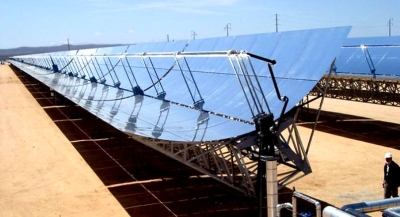
Linear concentrating systems
Linear concentrating systems collect the sun's energy using long, rectangular, curved (U-shaped) mirrors. The mirrors focus sunlight onto receivers (tubes) that run the length of the mirrors. The concentrated sunlight heats a fluid flowing through the tubes. The fluid is sent to a heat exchanger to boil water in a conventional steam-turbine generator to produce electricity.
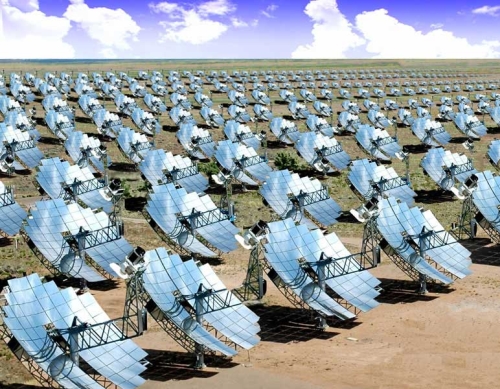
Parabolic troughs
A parabolic trough collector has a long parabolic-shaped reflector that focuses the sun's rays on a receiver pipe located at the focus of the parabola. The collector tilts with the sun to keep sunlight focused on the receiver as the sun moves from east to west during the day. Because of its parabolic shape, a trough can focus the sunlight from 30 times to 100 times its normal intensity (concentration ratio) on the receiver pipe, located along the focal line of the trough, achieving operating temperatures higher than 750°F. Parabolic trough linear concentrating systems are used in the longest operating solar thermal power facility in the world, the Solar Energy Generating System (SEGS), which has nine separate plants and is located in the Mojave Desert in California.
These reflectors use the Fresnel lens effect, which allows for a concentrating mirror with a large aperture and short focal length. These systems are capable of concentrating the sun's energy to approximately 30 times its normal intensity. The only operating linear Fresnel reflector system in the United States is a compact linear Fresnel reflector (CLFR)—also referred to as a concentrating linear Fresnel reflector—a type of LFR technology that has multiple absorbers within the vicinity of the mirrors. Multiple receivers allow the mirrors to change their inclination to minimize how much they block adjacent reflectors' access to sunlight. This positioning improves system efficiency and reduces material requirements and costs. Solar power tower Image of a solar power tower. Source: National Renewable Energy Laboratory (NREL)
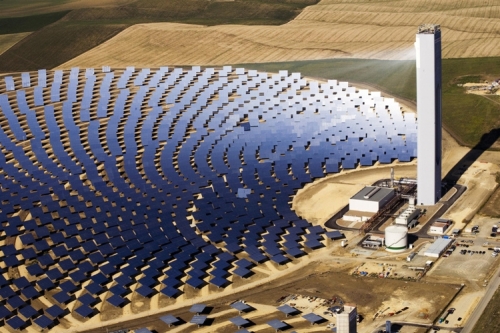
Solar power towers
A solar power tower system uses a large field of flat, sun-tracking mirrors called heliostats to reflect and concentrate sunlight onto a receiver on the top of a tower. Sunlight can be concentrated as much as 1,500 times. Some power towers use water as the heat-transfer fluid. Advanced designs are experimenting with molten nitrate salt because of its superior heat transfer and energy storage capabilities. The thermal energy-storage capability allows the system to produce electricity during cloudy weather or at night. Solar dish/engine systems use a mirrored dish similar to a very large satellite dish. To reduce costs, the mirrored dish is usually composed of many smaller flat mirrors formed into a dish shape. The dish-shaped surface directs and concentrates sunlight onto a thermal receiver, which absorbs and collects the heat and transfers it to an engine generator. The most common type of heat engine used in dish/engine systems is the Stirling engine. This system uses the fluid heated by the receiver to move pistons and create mechanical power. The mechanical power runs a generator or alternator to produce electricity.
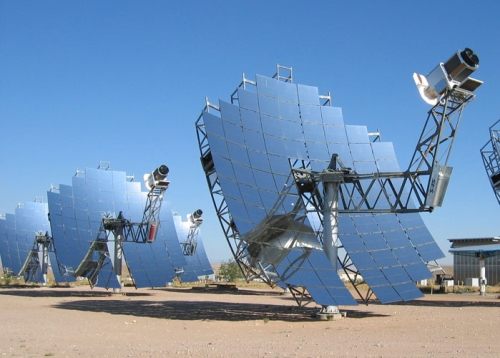
Solar dish/engine systems
always point straight at the sun and concentrate the solar energy at the focal point of the dish. A solar dish's concentration ratio is much higher than linear concentrating systems, and it has a working fluid temperature higher than 1,380°F. The power-generating equipment used with a solar dish can be mounted at the focal point of the dish, making it well suited for remote locations, or the energy may be collected from a number of installations and converted into electricity at a central point.

Glossary of PV Terms
Click on any term to receive the definition, then click on the term again to return here.
AC
Ampere
Ampere Hour
Ampere Hour Meter
Angle Of Incidence
Array
Balance Of System
Battery
Battery Capacity
Battery Cell
Battery Available Capacity
Battery Energy Capacity
Battery Cycle Life
Battery Life
Blocking Diode
Cathodic Protection
Cell (Battery)
Cell (Solar)
Charge Rate
Charge Controller
Concentrator
DC
Depth Of Discharge
Diffuse Insolation
Direct Insolation
Efficiency
Electrolyte
Electric Current
Electricity Energy
Electrons
Equalization
Equalizing Charge
Float
Service
Full
Sun
Gassing
Grid
Grid Lines
Hermetic Seal
Hybrid System
Incident Light
Insolation
Inverter
Kilowatt-Hour (Comparison Of Fuel Equivalents)
Load
Maximum Power
Module
Open Circuit Voltage
Panel
Parallel Connection
Peak Power Point
Peak Watts
Photon
Photovoltaic Cell
Photovoltaic Effect
Photovoltaic System
Power Conditioner
Power Factor
Regulator
Renewable Energy
Semiconductor
Series Connection
Silicon
Single-Crystal Structure
Solar Cell
Solar Panel
Stand-Alone System
Storage Battery
Sulfation
Telemetry Device
Tilt Angle
Tracking Array
Voltage
Watt
AC: Alternating Current. Direction of current reverses periodically, usually many times per second. Electricity transmission networks use AC because voltage can be controlled with relative ease.
Ampere (amp): A unit of electrical current or rate of flow of electrons. One volt across one ohm of resistance causes a current flow of one ampere. One ampere is equal to 6.235 x 1018 electrons per second passing a given point in a circuit.
Ampere hour: (amp hr. Or ah), a measure of current overtime, used to measure battery capacity.
Ampere hour meter:
An instrument that monitors current
with time. The indication is the product of current (in amperes) and
time (in hours).
Angle of Incidence: The angle between the direct solar beam and the normal (90 degrees) to the active surface (degrees).
Array: Any number of photovoltaic modules connected together electrically to provide a single electrical output. An array is a mechanically integrated assembly of modules or panels together with support structure (including foundation and other components, as required) to form a free- standing field installed unit that produces DC power.
Balance of systems (bos): Parts or components of a photovoltaic system other than the photovoltaic array.
Battery: Two or more electrochemical cells
enclosed in
a container and electrically interconnected in an appropriate
series/parallel arrangement to provide the required operating voltage
and current levels. Under common usage, the term battery also applies to
a single cell if it constitutes the entire
electrochemical storage system.
Battery capacity: The maximum total electrical charge,expressed in ampere-hours (ah), that a battery can deliver to a load under a specific set of conditions.
Battery cell: The simplest operating unit in a
storage
battery. It consists of one or more positive electrodes or plates, an
electrolyte that permits ionic conduction, one or more negative
electrodes or plates, separators between plates of opposite polarity,
and a container for all the above.
Battery available capacity: The total maximum charge, expressed in ampere-hours, that can be withdrawn from a cell or battery under a specific set of operating conditions including discharge rate, temperature, initial state of charge, age, and cutoff voltage.
Battery energy capacity: the total energy available,
expressed in watt-hours (kilowatt-hours), that can be withdrawn from a
fully-charged cell or battery. The energy capacity of a given cell
varies with temperature, rate, age, and cutoff voltage.
This term is more common to system designers than it is to the battery
industry where capacity usually refers to ampere-hours..
Battery cycle life: The number of cycles, to a specified depth of discharge, that a cell or battery can undergo before failing to meet its specified capacity or efficiency performance criteria..
Battery life: The period during which a cell or
battery
is capable of operating above a specified capacity or efficiency
performance level. For example, with lead-acid batteries, end-of- life
is generally taken as the point in time when a fully charged cell can
deliver only 80% of its rated capacity. Beyond this state of aging,
deterioration and loss of capacity begins to accelerate rapidly. Life
may be measured in cycles and/or years, depending on the type of service
for which the cell or battery is intended.
Blocking diode: A semiconductor connected in series
with a solar cell or cells and a storage battery to keep the battery
from discharging through the cell when there is no output, or low
output, from the solar cell. It can be thought of as a one-way valve
that allows electrons to flow forwards, but not backwards.
Cathodic protection: Systems that protect
underground
metal from corrosion by running small electrical currents along the
metal. Most often used to protect wellheads, oil, gas, and water
pipelines.
Cell (battery): A single unit of an electrochemical device capable of producing direct voltage by converting chemical energy into electrical energy. A battery usually consists of several cells electrically connected together to produce higher voltages. (sometimes the terms cell and battery are used interchangeably).
Cell (solar): The smallest, basic photovoltaic device that generates electricity when exposed to light.
Charge rate: The current applied to a cell or battery to restore its available capacity. This rate is commonly normalized by a charge control device with respect to the rated capacity of the cell or battery.
Charge controller: a component of photovoltaic system that controls the flow of current to and from the battery to protect the batteries from over-charge and over-discharge. The charge controller may also indicate the system operational status.
Concentrator: a photovoltaic module which includes optical components, such as lenses, to direct and concentrate sunlight onto a solar cell of smaller area. Most concentrator arrays must directly face or track the sun.
DC: Direct Current. A one way flow of electric current. Typical sources of direct currents are electric cells, rectified power units and direct current generators. This is the current flow produced by a solar cell system. To be used for typical 120 volt or 220 volt household appliances, it must be converted to AC.
Depth of Discharge (dod): The ampere-hours removed from a fully charged cell or battery, expressed as a percentage of rated capacity. For example, the removal of 25 ampere- hours from a fully charged 100 ampere-hours rated cell results in a 25% depth of discharge. Under certain conditions, such as discharge rates lower than that used to rate the cell, depth of discharge can exceed 100%.
Diffuse insolation: The radiant energy from the sky incident upon unit surface area during a specified time period (same units as for direct insolation).
Direct insolation: The radiant energy from the sun (and a small area of sky surrounding it, defined by the acceptance angle of the pyrheliometer) incident upon unit surface area during a specified time period. (mj/m2 per hour, day, week, month or year, as the case may be).
Efficiency: The ratio of power output of a photovoltaic cell to the incident power from the sun or simulated sun sources under specified standard insolation conditions.
Electrolyte: The fluid used in batteries as the transport medium for positively and negatively charged ions.
Electric current: The rate at which electricity
flows
through an electrical conductor, usually measured in amperes (amps).
Electricity energy: Resulting from the flow of charge particles, such as electrons ions.
Electrons: A negatively charged particle. The movement of electrons in an electrical conductor constitutes an electric current.
Equalization: The process of restoring all cells in a battery to an equal state-of-charge. For lead-acid batteries, this is a charging process designed to bring all cells to 100% state- charge. Some battery types may require a complete discharge as a part of the equalization process.
Equalizing charge: A continuation of normal battery charging, at a voltage level slightly higher than the normal end-of-charge voltage, in order to provide cell equalization within a battery.
Float service: A battery operation in which the battery is normally connected to an external current source; for instance, a battery charger which supplies the battery load under normal conditions, while also providing enough energy input to the battery to make up for its internal quiescent losses, thus keeping the battery always up to full power and ready for service.
Full sun: The full sun condition is the amount of power density received at the surface of the earth at noon on a clear day - about 100 mw/cm2. Lower levels of sunlight are often expressed as 0.5 sun or 0.1 sun. A figure of 0.5 sun means that the power density of the sunlight is one-half of that of a full sun.
Gassing: The evolution of gas from one or more of the electrodes in the cells of a battery. Gassing commonly results from local action self-discharge) or from the electrolysis of water in the electrolyte during charging.
Grid: Transmission line network used to distribute electric power.
Grid lines: Metallic contacts fused to the surface of the solar cell to provide a low resistance path for electrons to flow out to the cell interconnect wires.
Hermetic seal: Being impervious to external influences. Typically associated with the sealing of a package so that oxygen, moisture, and other outside environments cannot enter the package.
Hybrid system: a power system consisting of two or more power generating subsystems (e.g., The combination of a wind turbine or diesel generator and a photovoltaic system. The SES Photogenset® is an example of such a system.
Incident light: The incident light is the amount of light reaching an object.
Insolation: The amount of sunlight reaching an area. Usually expressed in milliwatts per square centimeter, or langleys.
Inverter: a device that converts electricity from DC to AC.
Kilowatt-hour unit of energy used to perform work (energy and work are equivalent in units, energy being the potential value and work the achieved value)
Fuel
equivalents:
one
barrel of crude contains roughly 1700 kwh
one
ton of coal contains roughly 7500 kwh
one
gallon of gasoline contains roughly 37 kwh
one
cubic foot of natural gas contains 0.3 kwh
one
ton of uranium ore contains 164 million kwh 1.34
horsepower-hours.
Thermal
unit:
one
kwh = 3400 btu. Can be compared to 860 calories
(food
value)
Example:
The
'average Australian home uses about 20 kwh of
electricity per day. Heating 12Litres of water from 30 degrees to the
boiling point requires 1 kwh. A 200 watt photovoltaic array of six, 50
watt solar modules, will generate 1 kwh in an "average" day
(annualized average equivalent of 5 hours peak sunlight per day).
Load: Refers to equipment that is powered by electricity. Usually expressed in terms of amperes or watts. In an electrical circuit, any device or appliance that uses power (such as a light bulb or water pump).
Maximum power: The power at the point on the current-voltage characteristic where the product of current and voltage is a maximum (measured in watts).
Module: The smallest non divisible, self-contained and environmentally protected physical structure housing interconnected photovoltaic cells and providing a single DC electrical output.
Open circuit voltage (ocv): Voltage produced by a
photovoltaic cell with noload applied when the cell is exposed to
standardinsolation conditions, measured with a voltmeter.
Panel: A collection of one or more modules fastened together into a single unit, often factory pre- assembled and wired, forming a field-installable unit.
Parallel connection: A wiring configuration used to increase current (amperage). Parallel wiring is positive to positive (+ to +) and negative to negative (- to -). Opposite of a series connection.
Peak power point: Operating point of the i-v (current-voltage) curve for a photovoltaic cell or module where the product of the current value times the voltage value is a maximum.
Peak watts: The measurement of electricity produced by a solar generator at noon on a sunny day, under predetermined standard conditions.
Photon: The actual (physical) particle unit of
light,
as the electron is of electric charge and the atom and molecule are of
matter. Light has both wave properties and particle properties. Violet
light has relatively short wavelength and higher energy in its photons;
red light has longer wavelength, lower-energyphotons. The wavelength
and/or energy spectrum of the sun extends in both directions beyond the
visible range of light, of course, and the silicon module solar cell can
capture some energy both of these invisible zones. Photons not captured
by the cell are either reflected or converted to heat in the solar
array.
Photovoltaic cell: A device composed of specially prepared semiconductor material or material combinations exhibiting the ability to convert incident solar energy directly into electrical energy.
Photovoltaic effect: The phenomenon that occurs when photons, the "particles" in a beam of light, knock electrons loose from the atoms they strike. When this property of light is combined with the properties of semiconductors, electrons flow in one direction across a junction, setting up a voltage. With the addition of circuitry, current will flow and electric power will be available.
Photovoltaic system: An installed aggregate of solar
arrays generating power for a given application. A system may include
the following sub-systems:
a.
support foundation
b.
power conditioning and control equipment
c.
storage
d.
active thermal control
e.
land security systems and buildings
f.
conduit/wiring
g.
instrumentation
Power conditioner: The electrical equipment used to convert power from a photovoltaic array into a form suitable for subsequent use. Loosely, a collective term for inverter, transformer, voltage regulator and other power controls.
Power factor: The ratio of real power (watts) to
apparent power (volt amps) in an AC circuit. Displacement power factor
is the ratio of fundamental watts to fundamental RMS volts times RMS
amps, excluding the effects of all harmonic exponents; it could be
called fundamental power factor.
Regulator: Prevents overcharging of batteries by controlling charge cycle - usually adjustable to conform to specific battery needs.
Renewable energy: Flows of energy that are regenerative or virtually inexhaustible. Most commonly includes solar electric and thermal), biomass, geothermal, wind, tidal, wave, and hydro power sources.
Semiconductor: A material such as silicon, which has
a
crystalline structure that will allow current to flow under certain
conditions. Semiconductors are usually less conductive than metals but
not an insulator like rubber.
Series connection: A wiring configuration used to increase voltage. Series wiring is positive to negative (+ to -) or negative to positive (- to +). Opposite of parallel connection.
Silicon: A non-metallic element, that when specially treated, is sensitive to light and capable of transforming light into electricity. Silicon is the basic material of most beach sand, and is the raw material used to manufacture most photovoltaic cells.
Single-crystal structure: A material having a crystalline structure such that a repeatable or periodic molecular pattern exists in all three dimensions.
Solar cell: The basic photovoltaic device which generates electricity when exposed to sunlight.
Solar panel: A collection of solar modules
connected in
series, in parallel, or in series- parallel combination to provide
greater voltage, current, or power than can be furnished by a single
solar module. Solar panels can be provided to furnish any desired
voltage, current, or power. They are made up as a complete assembly.
Larger collections of solar panels are usually called
solar arrays.
Stand-alone system: (sos) a system which operates independently of the utility lines. It may draw supplementary power from the utility but is not capable of providing power to the utility.
Storage battery: A device capable of transforming energy from electric to chemical form and vice versa. The reactions are almost completely reversible. During discharge, chemical energy is converted to electric energy and is consumed in an external circuit or apparatus.
Sulfation: The formation of lead sulfate crystals on the plates of a lead-acid battery. Commonly used to indicate the large crystals which form in partially discharged cells as the result of temperature cycling. These large crystals are more difficult to reduce by the charging current than are the smaller crystals that result from normal and self-discharge reactions. Sulfating can be caused by leaving the battery in a discharged state for long periods of time.
Telemetry device: Devices used to transmit or receive data in a digital form.
Tilt angle: A fixed angle measured from the horizontal to which a solar array is tilted. The tilt angle is chosen to maximize the array output. Depending upon latitude, season and time of day this angle will vary.
Tracking array: An array that is mounted on a movable structure that attempts follow the path of the sun. Some tracking arrays are single axis while others are dual.
Voltage: A measure of the force or "push" given the electrons in an electrical circuit; a measure of electrical potential. One volt produces one amp of current when acting against a resistance of one ohm.
Watt: Unit of power. Power is the rate of using
energy to do work.
Additional
items of interest:
mechanical:
746 watts = 1 horsepower
electrical:
one watt is the power developed or
dissipated
in one volt circuit
(see
volt) in which a current of one ampere (6
1/4
million electrons per second) is flowing.
Watts
= amps x volts.
Thermal:
1 watt = about 14.3 calories of heat
energy
per minute. =3.413 BTU per hour =1 joule/sec.
Examples:
typical 4" silicon cell produces about 1 watt at peak (noontime
sunlight). One 1.3m fluorescent tube used 40 watts. One watt will heat
announce of water from the freezing point to the boiling point in a
little over 3hours. The sun delivers (at peak) about 100 watts 30sqcm of
surface normally.

